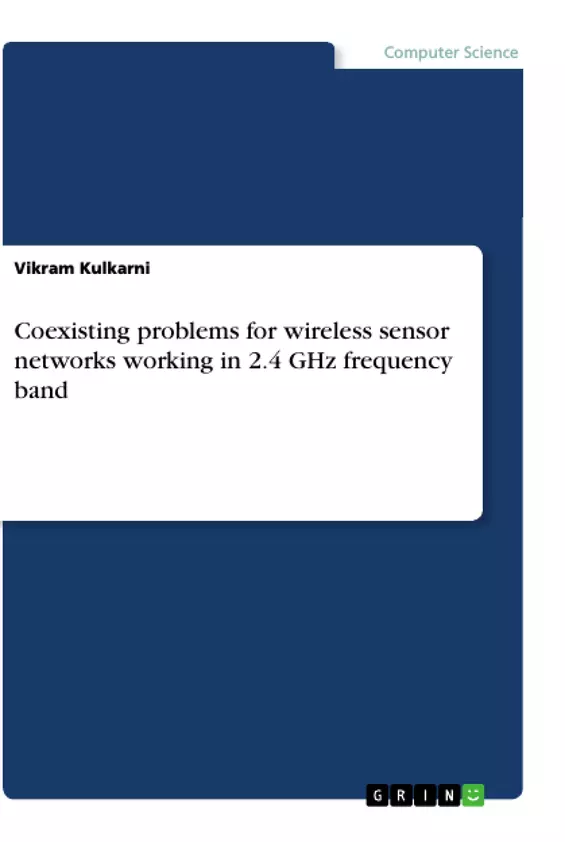The objectives of this research are: To propose a scheme to estimate the future interference and enable efficient channel switching mechanism to avoid interference for Wireless Sensor Network (WSN) as per the latency requirements specified by Smart Grid (SG). To propose an algorithm for efficient data recovery mechanism so that ZigBee devices can quickly familiarize with the encoding according to the highly dynamic WiFi traffic. To propose an efficient frequency shifting mechanism for different frame sizes of data under interference conditions to guarantee the reliable data transmission within the delay requirements of the SG. To propose an effective mechanism to guarantee the ZigBee communications within the maximum tolerable delay under the coexistence of WiFi for carrying out effective smart home solutions. To propose an algorithm based on effective transmission power control to increase WSN life time under coexistence scenarios for efficient monitoring and controlling purposes at smart homes.
With the introduction of Information and Data-Communication Technology (ICT) to the present electrical power systems, the traditional electrical-grid system is becoming more intelligent and adaptive. The ICT successfully establishes bi-directional communication between Utility companies and the consumer for improving the generation and utilization of power. Wireless Sensor Network (WSN) is efficiently utilized by wide-ranging Smart Grid (SG) applications. Despite many advantages, WSN faces a challenge of avoiding interference experiencing from other coexisting wireless technologies working in the 2.4GHz unlicensed frequency band. Providing support for WSN in terms of avoiding interference is a very challenging issue due to the dynamic wireless communication environment and extremely limited resources. In the present thesis, the problem of interference experienced by WSN in 2.4GHz has been investigated.
The challenges, limitations and requirements for avoiding the interference for WSN working in the vicinity of other technologies like WiFi and Bluetooth have been identified. As a result of the literature survey carried out, it was identified that proper channel se-lection and channel prioritization for WSNs working in the coexisting environment had not been adequately developed till then. Hence, there was a requirement for addressing these issues. The proposed schemes in this thesis are based on simulation results obtained.
Inhaltsverzeichnis (Table of Contents)
- Introduction
- Introduction
- The Introduction to Smart Grid Communication System Scenario
- The Home Area Networks for SG Applications
- The Neighbourhood Area Network (NAN) for SG Applications
- The WAN for SG Applications
- The WSN Protocol design goals for SG applications.
- Reliability of WSN
- Quality of Service Requirements for WSN
- Interference Avoidance
- Energy Consumption
- Interoperability
- Memory Management.
- Security
- Heterogeneous system conditions.
- Research Motivation.
- Research Objectives
- A Review on Interference Avoiding Methods for WSN working in the 2.4GHz ISM Band
Zielsetzung und Themenschwerpunkte (Objectives and Key Themes)
This book investigates the problem of interference experienced by Wireless Sensor Networks (WSN) in the 2.4GHz frequency band, focusing on applications in Smart Grid (SG) systems. The work identifies challenges, limitations, and requirements for avoiding interference in the context of coexisting technologies like WiFi and Bluetooth. The book aims to propose and evaluate novel schemes for improving the performance of WSNs operating under the influence of WiFi, ultimately enhancing the efficiency and reliability of Smart Grid communication.
- Interference avoidance for WSN in the 2.4GHz band
- Smart Grid communication system scenarios
- Performance optimization of WSNs under WiFi influence
- Channel selection and prioritization techniques
- Quality of Service (QoS) parameters for WSN in Smart Grid applications
Zusammenfassung der Kapitel (Chapter Summaries)
- Introduction: This chapter introduces the concept of Smart Grid communication systems, focusing on the role of WSNs in various network scenarios, including Home Area Networks (HANs), Neighbourhood Area Networks (NANs), and Wide Area Networks (WANs). The chapter outlines the protocol design goals for WSNs in SG applications, emphasizing reliability, QoS, interference avoidance, energy consumption, interoperability, memory management, security, and heterogeneous system conditions. It also presents the motivation and objectives of the research.
- A Review on Interference Avoiding Methods for WSN working in the 2.4GHz ISM Band: This chapter reviews existing methods for avoiding interference in WSNs operating within the 2.4GHz band. It examines the limitations of current techniques and identifies the need for more effective solutions, setting the stage for the novel approaches proposed in the subsequent chapters.
Schlüsselwörter (Keywords)
The key focus areas of this book include Home Area Networks, interference avoidance, Smart Grid communications, the 2.4GHz frequency band, and Wireless Sensor Networks. The research emphasizes the development of novel schemes for optimizing WSN performance by addressing challenges related to interference, channel selection, and energy consumption in the context of Smart Grid applications.
- Arbeit zitieren
- Dr. Vikram Kulkarni (Autor:in), 2019, Coexisting problems for wireless sensor networks working in 2.4 GHz frequency band, München, GRIN Verlag, https://www.grin.com/document/509404



